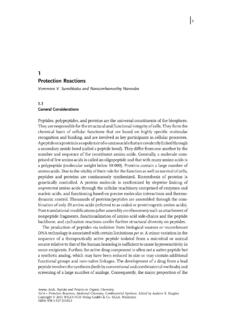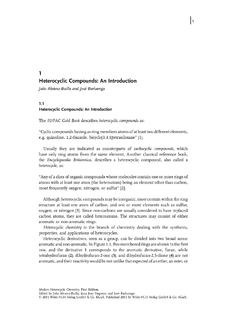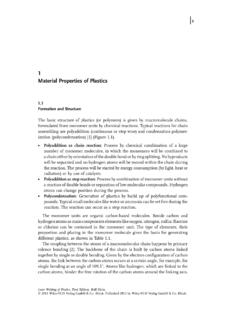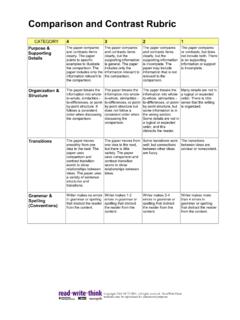Transcription of 1 Water Resources: Quantity and Quality - Wiley-VCH
1 J1. 1. Water Resources: Quantity and Quality Water pollution, together with loss of biodiversity, climate change, energy and socio- economic issues, is one of the main threats and challenges humanity faces today. Human activities and human-related substances and wastes introduced into rivers, lakes, groundwater aquifers and the oceans modify the environmental Water Quality and make huge quantities of Water unsuitable for various uses. This is the case not only for human-related uses such as drinking, bathing, agricultural irrigation and industrial production but also for terrestrial and aquatic ecosystems for which clean, fresh Water is a prerequisite for life. Water pollution is a serious problem for human health and the environment. The extent of the problem has been con rmed by many reports from UN organisations and related statistics. For example the Global Environment Outlook report (2000). produced by the United Nations Environment Programme (UNEP) included the following statistics.
2 Already one person in ve has no access to safe drinking Water .. Polluted Water affects the health of billion people every year, and contributes to the death of 15 million children less than 5 years of age every year.. Three million people die every year from diarrhoeal diseases (such as cholera and dysentery) caused by contaminated Water .. Vector-borne diseases, such as malaria, kill another million people per year, with inadequate Water management a key cause of such diseases. Water pollution contributes to the so-called global Water crisis , because it reduces the available amount of freshwater resources for both people and ecosystems. Freshwater scarcity is already a reality in many parts of the world, not only in developing countries like India, China and many African countries, but also in countries and regions traditionally considered as Water rich, such as the USA and Europe. The United Nations (UN) predicts that two-thirds of the world s population will live in Water -scarce regions by 2025.
3 The increase in Water demand, together with the increase in population in many parts of the world, but mainly the over use of Water in areas like agriculture, together with Water pollution and climate change are the main driving forces behind this phenomenon. Risk Analysis of Water Pollution: Second, Revised and Expanded Edition. Jacques Ganoulis Copyright 2009 Wiley-VCH Verlag GmbH & Co. KGaA, Weinheim ISBN: 978-3-527-32173-5. j 1 Water Resources: Quantity and Quality 2. The Quality of Water resources and aquatic ecosystem preservation are very much related to the design and operation of hydraulic engineering structures, such as dams, reservoirs and river levees. Until now the design of these structures has paid far greater attention to cost, bene t and safety than to issues of environmental impact. Technical projects such as wastewater treatment plants, management of waste disposal and remediation of contaminated sites, which aim to treat wastewaters and therefore improve Water Quality , also produce various environmental hazards and risks.
4 To face real situations of Water resources pollution, the ef cient application of an environmental impact assessment, including data acquisition, risk analysis and examination of institutional aspects of Water resources management, is of crucial importance. In this book the term Water resources covers fresh surface Water and groundwater, as well as coastal Water resources. Many new techniques for risk assessment and management have been developed recently both in the USA and Europe (Duckstein and Plate, 1987; Ganoulis, 1991c;. Haimes et al., 1992; Morel and Linkov, 2006; Hlavinek et al., 2008). These techniques aim to quantify the risks arising from the various uses of Water , for example urban Water supply, irrigation and industrial processes. However, few of these develop- ments have ltered into academic curricula, and even fewer into engineering practice. The main objective of this book is to present, in a uni ed framework, methods and techniques of risk and reliability analysis for evaluating the impact on environmental Water Quality from different Water uses, wastewater disposal and Water resources management planning.
5 Risk and reliability analysis has also been used in elds other than engineering, for example in social, economic and health sciences. Risks have been analysed within these disciplines in relation to public policy, administration, nancing or public health. Public risk perception, social behaviour and attitudes under risk, risk costs and exposure assessment are some of the major topics of study. In this book environmental risk and reliability analysis is discussed, as applicable speci cally to Water pollution in the natural environment. Risk and reliability analysis may also provide a general methodology for the assessment of the safety of Water - related engineering projects. In Water pollution problems, risk is related to various uncertainties in the fate of pollutants. Thus, risk and reliability assessment of Water pollution is a useful tool to quantify these uncertainties and evaluate their effect on Water resources.
6 In this respect, the important technical aspects are the management of hydrosystems (rivers, lakes, aquifers and coastal areas) taking into account Water Quality and environmental impacts, the design of environmental amenities, the management of waste disposal, the optimum operation of wastewater treatment plants and the remediation of contaminated sites. Important features covered in this book are: . Uncertainty Analysis of Water Quantity and Quality .. Stochastic Simulation of Hydrosystems: model selection, Water Quantity and Quality assessment and changes in Water Quality due to possible climate change in coastal waters, risk of groundwater and river pollution.. Application of fuzzy Set Theory in Engineering Risk Analysis. Water Pollution and Risk Analysis j3.. Decision Theory under Uncertainty: risk management, risk cost trade-offs.. Case Studies. Environmental Water pollution could lead to public health hazards (risk to human health), deterioration of Water Quality and damage to ecosystems (environmental risk) or may cause economic consequences (economic risk).
7 In this sense, environ- mental risk and reliability analysis is an interdisciplinary eld, involving engineers, chemists, biologists, toxicologists, economists and social scientists. Although there is a strong interaction between these disciplines and for speci c applications only team work is appropriate, this book focuses mainly on the technical and engineering aspects of environmental risk. In this introductory chapter the role of engineering risk and reliability analysis in Water pollution problems is further clari ed. After stressing the importance of both natural Water resources and Water Quality , environmental risk assessment and management are explained and the organisation of material presented in the following chapters is summarised. Water Pollution and Risk Analysis Risk and reliability have different meanings and are variously applied in different disciplines such as engineering, statistics, economics, medicine and social sciences.
8 The situation is sometimes confusing because terminologies and notions are transferred from one discipline to another without modi cation or adjustment. This confusion is further ampli ed as scientists themselves can have different perceptions of risks and use different tools to analyse them. Risk has different de nitions in engineering, economic, social and health sciences. Risk analysis is mainly based on the quanti cation of various uncertainties which may occur in the evolution of different processes. The use of modelling techniques to quantify such uncertainties is an essential part of risk analysis. Furthermore, because preventive and remedial actions should be based on predictions of how processes might develop under uncertainty in the future, probabilistic approaches are more appropriate for this purpose than deterministic methods. Probabilities, and more recently the fuzzy set theory, are suitable tools for quantifying uncertainties which may induce a risk of failure.
9 Water Quantity and Quality problems are very much inter-related and should be studied within an integrated framework. Furthermore, Water Quality is related to the integrity of ecosystems and these should be analysed together. This uni ed approach has been adopted in this book. After reviewing the importance of Water resources and the need for good Water Quality for sustainable economic development, the manage- ment of Water resources is analysed. The latter is based on both the design and decision making processes, in which various uncertainties may exist. The concept of quanti cation of these uncertainties and how one may proceed from the assessment to the management of risks are presented in the following pages and discussed in detail in Chapters 2 and 3. j 1 Water Resources: Quantity and Quality 4. A Systemic View of Water Resources The total volume of Water on Earth is estimated at 1360 million cubic kilometers or 1338 106 km3 (Gleick, 1996 and USGS).
10 This number was derived from a long-term assessment of the average amount of Water stored in the hydrosphere, that is, that part of the Earth covered by Water and ice, the atmosphere and the biosphere (all living organisms on Earth). About 70% of the Earth s surface is covered by oceans. The salt Water in the seas and oceans represents 97% of the total Water on Earth, the remaining 3% being fresh Water . Freshwater is distributed in different components (glaciers, rivers, lakes, ground- Water , atmosphere and biosphere) as shown in Table From this table it can be seen that the greatest part ( ) of total freshwater is trapped in polar glaciers and ice sheets, and is therefore not directly accessible for use. Only of the freshwater on Earth is surface Water , in the form of lakes (87%) and rivers (2%). Table Distribution of freshwater on Earth. Source of freshwater (estimate) Percentage of the total freshwater Glaciers and permanent snow cover Groundwater Freshwater lakes Rivers Atmosphere Biosphere Water exists in three states: liquid, solid (ice and snow) and gas ( Water vapour).
















